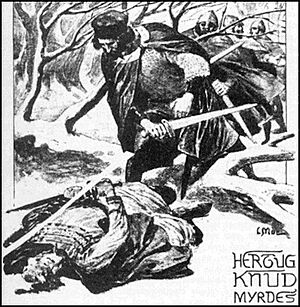Magnus the Strong facts for kids
Quick facts for kids Magnus the Strong |
|||||
|---|---|---|---|---|---|
| King of Götaland, or possibly Sweden | |||||
| Reign | 1120s – c. 1132 | ||||
| Predecessor | Inge the Younger | ||||
| Successor | Sverker the Elder | ||||
| Co-king of Denmark | |||||
| Reign | 15 April 1134 – 4 June 1134 | ||||
| Coronation | 15 April 1134 | ||||
| Senior king | Niels | ||||
| Born | c. 1106 | ||||
| Died | 4 June 1134 (aged 27–28) Fotevik, Scania |
||||
| Spouse | Richeza of Poland | ||||
| Issue | Canute V of Denmark Niels |
||||
|
|||||
| House | Estridsen | ||||
| Father | Niels I of Denmark | ||||
| Mother | Margaret Fredkulla | ||||
Magnus the Strong (born around 1106 – died June 4, 1134) was also known as Magnus Nilsson. He was a Danish duke who ruled a part of southern Sweden called Gothenland from the 1120s until about 1132. It's not fully clear if the Swedes chose him as their king. However, he is sometimes listed as Magnus I in modern lists of Swedish kings. He was also briefly a co-king of Denmark in 1134.
Contents
Early Life and Personality
Magnus was the son of King Niels I of Denmark and Margaret Fredkulla. His mother, Margaret, was the daughter of King Inge the Elder of Sweden. Magnus became the only heir to his father, King Niels, after his older brother Inge died in a riding accident.
Magnus grew up to be a very tall and strong young man. He was said to be a head taller than most people. Old writings describe his personality differently. Some say he was cheerful and generous. Others, like Saxo Grammaticus, said he was naturally gifted but also violent.
Becoming a King
When his mother's cousin, King Inge the Younger, died in the 1120s, Magnus claimed the Swedish throne. He was the oldest grandson of Inge the Elder. According to the writer Saxo Grammaticus, the people of Gothenland (called the Geats) accepted Magnus as king. However, the tradition was that the Swedes, another tribe to the north, usually chose the king.
An old Swedish law book from Västergötland does not mention Magnus. It says that after Inge's death, the Swedes chose Ragnvald Knaphövde as king. Ragnvald did not show proper respect to the Geats during his royal tour. Because of this, the Geats killed him, possibly around 1129. After Ragnvald's death, a local leader named Karl of Edsvära governed the area for a time.
Saxo Grammaticus does not name Ragnvald. But he mentions that the Swedes chose a king after Magnus was elected. This king was then killed by the Geats, and "power was transferred to Magnus." Magnus is not listed as king in any Swedish king-list. This makes his true power in Sweden a bit unclear.
His Time as Ruler
During this time, Christianity was still spreading in Sweden. The bishop of Uppsala, Siwardus, had to leave in 1130 because of "pagans" (people who did not follow Christianity). Another bishop, Henry, was then appointed in Sigtuna. Henry was a strong supporter of Magnus. These changes show the competition between different church leaders.
There is also a story that Magnus once went on a Viking trip to a part of Sweden. He supposedly took some heavy Thor's Hammers from a holy island. The Swedes, who were not fully Christian yet, saw him as someone who had robbed their gods.
Around 1127, Magnus married Richeza. She was the daughter of Boleslaw III of Poland. Magnus and Richeza had two sons: Canute (born 1129), who later became king of Denmark, and Niels (born 1130). In 1130, Magnus helped Boleslaw III conquer Rügen. Polish forces and a Danish fleet made the local people accept Polish rule over the island.
Danish Civil War and Death
In 1131, Magnus was involved in the death of his cousin, Canute Lavard. Canute was a possible rival for the Danish throne. After this event, Magnus had to return to Gothenland, where he was still seen as king. Even though his father, King Niels, supported him, Magnus found himself in a civil war. He was fighting against Canute Lavard's half-brother, Eric Emune.
This civil war weakened Magnus's power in Sweden. The Swedes then chose a new king, Sverker I, from Östergötland. According to Saxo, this happened around 1132.
Magnus and his father, King Niels, fought against Eric Emune in the Battle of Fotevik in Scania. This battle took place on June 4, 1134. Saxo writes that King Niels panicked and fled. But Magnus faced his enemies with a small group of loyal followers. He chose to fight and die rather than run away and lose his reputation for bravery. He fought bravely and killed many enemies before he fell. After this major defeat, Niels escaped but was killed later that same year.
What Happened After

After Magnus died, his wife Richeza went back across the Baltic Sea. She married Volodar of Minsk, a ruler from a Viking family. Later, she returned to Sweden and married King Sverker I, the man who had defeated Magnus.
Magnus's son, Canute V, later fought for the Danish throne against his second cousin, Svend III. When Canute died in 1157, Magnus's direct family line ended. Canute's older son, Niels, died in 1180. Canute also had a son born after his death, Valdemar. Valdemar became a bishop and died in 1236. He was the last direct male descendant of King Magnus.
See also
 In Spanish: Magnus Nilsson de Dinamarca para niños
In Spanish: Magnus Nilsson de Dinamarca para niños


